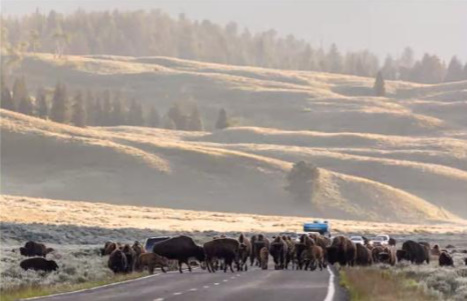
By Kara Reedy —
The Fall 2023 semester has been filled with interactive events and fascinating presentations, many of which have been led by Dr. Tammie Gerke, who has, for the last few years, consistently held a series called the National Parks Talk. Dr. Gerke wrapped up the Fall 2023 edition of the series with help from the librarians at the Gardner-Harvey Library. This semester has all been above volcanoes, ending with one of the most mysterious and awe-inspiring volcanoes in the world: Yellowstone.
Yellowstone National Park is in a unique location. The park is predominantly located in Wyoming, with a sliver or two found in Montana and Idaho. The park is massive, and is populated with a diverse group of animals, including bison, which have become synonymous with Yellowstone. There are over 10,000 water features in Yellowstone National Park, with the main attractions being hot springs, geysers, and mud pots, which are Dr. Gerke’s favorite. The Grand Prismatic Spring is one of the most popular hot springs in the park, primarily due to its vibrancy, which is caused by microorganisms making the water rich with color-changing minerals. Visitors to Yellowstone National Park can get an upfront view of the spring, but it is possible to get too close due to the dangers of the boiling water. There are just over 500 geysers in the park, yet that number also happens to be 62% of the total across the globe, making Yellowstone National Park the best place to see them.
The most famous geyser in the park is Old Faithful, but that name apparently doesn’t seem to fit as well as it used to. Like everywhere else in the world, Yellowstone National Park has experienced significant devastation from climate change, and even Old Faithful itself has been harmed. This geyser used to be true to its name since it would erupt every 60 minutes, nearly to the second, for decades. Nowadays, it’s now somewhat more difficult to correctly predict when the geyser will erupt, with many visitors finding that eruptions are now separated somewhere between 60 and 90 minutes.
Dr. Gerke also said that many suspect that the continued seismic disturbance in the region could have caused this disruption. Yellowstone experiences anywhere from 1,000 to 3,000 earthquakes every year, making the park as one of the most seismically active places in the United States. The earthquakes just so happen to be centered around the location of the volcano. However, there’s no need for alarm, since earthquakes around volcanoes are perfectly normal. There was a rumor going around in the recent past that suggested the volcano was close to a catastrophic eruption, yet scientists and park officials have since informed the public that there is no danger of eminent eruption in the foreseeable future. Volcanologists have been keeping an eye on Yellowstone for decades now, with past eruptions to guide them in their attempts to monitor the volcano.
That’s right, past eruptions. Yellowstone has had three especially noteworthy eruptions in the past 2.1 million years, with the first leading to around 6,000 times more material being expelledthan the Mt. Saint Helen eruption in 1980—25,000 cubic kilometers. The following two eruptions weren’t as powerful as the first, with one happening 1.3 million years ago and the other occurring 640,000 years ago. This third eruption formed the thirty to forty-five mile wide caldera that Yellowstone is now recognized for. Ash from the eruptions traveled as far south as Mexico, as far east as Louisiana, and as far north as Canada. Scientists analyzing the Yellowstone volcano suspect that around eighty eruptions have taken place since the last extensive eruption 640,000 years ago.
While the volcano at Yellowstone shouldn’t alarm you, but the animals probably should. Grizzly bears and bison roam the park, and many visitors can tell a story or two to tell about being halted in traffic by a herd of bison lounging on the road. There are a reported 6,000 bison and anywhere between 150 and 1,000 grizzly bears. It’s a difficult task trying to figure out exactly how many bears there are as compared to bison, since the latter travel in noticeable herds. Visitors can also come across petrified trees, courtesy of volcanic ash. The rings in the tree bark are still visible, although getting a good look into them isn’t as easy as it used to be due to restrictions.
In fact, a good deal of the park has had to be restricted due to the encroachment of climate change. Yellowstone National Park withstood torrential downpours in June 2022, resulting in intense mudslides that wiped out entire roads, bridges, and plenty of other parts of Yellowstone’s infrastructure. Extreme damage threatened the park, forcing the heavily affected areas to be shut down. Luckily, the flood didn’t completely destroy the vibrant ecosystem in Yellowstone, but what if it had? The National Park Service has been keeping an especially close eye on the parks in recent years as climate change intensifies. We need to remember just how important the parks are, not just as public spaces, but as places where we can witness the beauty of nature.
Dr. Gerke’s National Parks Talk Series will return in the Spring 2024 semester with the addition of three more presentations. Dr. Gerke is planning on returning to her archaeological roots, focusing on Dinosaur National Monument, the UNESCO World Heritage sites in Ohio, and Fort Frederic in the Crown Point State Historic Site. We look forward to seeing you at these future events.
Contact Information:
- Dr. Tammie Gerke – gerketl@miamioh.edu
- Jessie Long – longjh@miamioh.edu
- John Burke – burkejj@miamioh.edu
